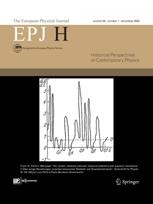Quantum Gravity, Effective Field Theory, and Strings
A historical overview of different approaches to the quantum theory of gravitation from the early twentieth century shows how they have been combined to set our modern view of a unified ‘theory of everything’.
New York | Heidelberg, 3 May 2024
 Gravity is one of four fundamental interactions. The most precise description of this force is still provided by Einstein’s General Theory of Relativity, published in 1915, an entirely classical theory. This description sets gravity apart from the other three forces - strong, weak, and electromagnetism - all described by quantum fields. Therefore, any attempt to unify the four forces must depend on a description of gravity that uses the principles of quantum mechanics. This has been an active area of theoretical physics since the 1930s. A historian and a physicist, Alessio Rocci from VUB in Brussels and Thomas Van Riet from KU Leuven in Belgium have set out a historical overview of the development of quantum theories of gravity to explain our current view on a future unified theory of the four forces. This work has now been published in the journal EPJ H: Historical Perspectives on Contemporary Physics.
Gravity is one of four fundamental interactions. The most precise description of this force is still provided by Einstein’s General Theory of Relativity, published in 1915, an entirely classical theory. This description sets gravity apart from the other three forces - strong, weak, and electromagnetism - all described by quantum fields. Therefore, any attempt to unify the four forces must depend on a description of gravity that uses the principles of quantum mechanics. This has been an active area of theoretical physics since the 1930s. A historian and a physicist, Alessio Rocci from VUB in Brussels and Thomas Van Riet from KU Leuven in Belgium have set out a historical overview of the development of quantum theories of gravity to explain our current view on a future unified theory of the four forces. This work has now been published in the journal EPJ H: Historical Perspectives on Contemporary Physics.
Physicists began to investigate the quantum theory of gravitation in the 1930s, taking a perturbative approach, convinced that there should be no fundamental difference between the gravitational force and the other interactions. However, finding a description of the gravitational interaction according to the laws of quantum mechanics is still a very complex task.
Later in the century, Steven Weinberg, a pioneer of both Effective Field Theory and the Standard Model of particle physics, began a process of cross-fertilization between these areas and the research area of quantum gravity that produced our current view on Einstein’s theory. From the mid-1980s, string theory set up a possible framework to approach quantum gravity using a ‘top-down’ approach. The effective field theory approach to strong forces drove the development of the ‘bottom-up’ perspective, culminating in the mid-1990s.
Recently, physicists have started a new program called Swampland to overcome the criticism of string theory that arose in the 2000s. Van Riet says: “The ultimate hope is that the Swampland program can lead to general patterns with observational consequences.”
Reference: Rocci, A., Van Riet, T. The quantum theory of gravitation, effective field theories, and strings: yesterday and today. EPJ H 49, 7 (2024). https://doi.org/10.1140/epjh/s13129-024-00069-4
Further Information
For more information visit: www.epj.org
Services for Journalists
The full-text article is available here.
Contact
Sabine Lehr | Springer | Physics Editorial Department
tel +49-6221-487-8336 | sabine.lehr@springer.com
